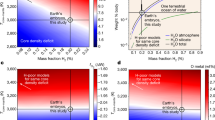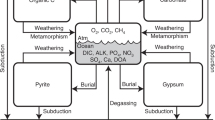Abstract
Arising from: B. J. Wood & A. N. Halliday Nature 437, 1345–1348 (2005); Wood & Halliday reply
Constraining the timing of the formation of Earth's core, which defines the birth of our planet, is essential for understanding the early evolution of Earth-like planets. Wood and Halliday1 and Halliday2 discuss the apparent discrepancy between the U–Pb (60–80 Myr) and Hf–W clocks (30 Myr) in determining the timescale of Earth's accretion and core formation. We find that the information the authors present is at times contradictory (for example, compare Fig. 1 in ref. 1 with Fig. 1 in ref. 2) and confusing and could suggest that the U–Pb clock constrains core formation better than the Hf–W system. Here we point out the limitations of the U–Pb system and show that the U–Pb age cannot be used to argue for protracted accretion and/or core formation (>50 Myr) because this clock only records the processes that occurred during the last 1% of Earth's accretion and core formation in the Wood and Halliday mechanism1.
Similar content being viewed by others
Main
For both the U–Pb and Hf–W systems to be able to date Earth's accretion and core formation, we need accurate estimates of the following parameters: the initial Solar System tungsten and lead isotope ratios; the bulk Earth elemental ratios of Hf/W and U/Pb; the present tungsten and lead isotope composition of the silicate Earth; and the present U/Pb and Hf/W ratios of the silicate portion of Earth. Whereas we know all the required parameters for the Hf/W system, several of the parameters for the U/Pb system are highly uncertain and are unlikely ever to be determined accurately enough to infer age resolution of a few tens of millions of years at 4.5 Gyr ago.
First, the U/Pb ratio of the bulk Earth (that is, µTOTE in ref. 1) is not well known, as it is a ratio of a refractory and a volatile element. Rocky planetary objects are depleted in volatile elements, including Pb to various degrees. We therefore have no way of knowing a priori what the building-blocks of Earth are made of in terms of the U/Pb ratio. The same is not true for the Hf–W system, as both elements are refractory. The bulk Earth Hf/W ratio has been estimated from that of primitive chondritic values with a high degree of confidence3,4. Using refractory elements for estimating the bulk composition of planets is one of the cornerstones of modern geochemistry.
Second, because of the long half-lives of 238U (∼4.5 Gyr) and 235U (∼0.7 Gyr), the lead isotope composition of terrestrial rocks varies widely and is continuously evolving. As a result, there is no easy way of deriving a single value for the present lead isotope composition of the bulk silicate Earth that can be used to date early Earth events precisely within the first 30 Myr. The same is not true for the Hf–W system. The now-extinct radionuclide 182Hf only has a 9-Myr half-life and decayed to 182W. Every rock on the surface of Earth records a single value of 182W, which is 2 parts per 10,000 higher than the bulk Earth value (obtained from chondrites). The difference is a consequence of metal extraction during core formation, which also produces a high Hf/W ratio in the silicate portion of Earth. Thus, we have a well-determined tungsten isotope composition for the bulk silicate Earth, but a highly uncertain one for lead isotopes.
The accretion process is not a well-defined point in time and, in fact, is technically still continuing today. The best designation of the 'end' of our planet's formation (>99% mass accreted) is probably the final major event in Earth's accretion process, the formation of the Moon by a Mars-sized impactor. This time is constrained by the tungsten isotope data to be about 30 million years after the formation of the Solar System4,5,6,7,8. New tungsten isotope data from lunar samples reinforce this conclusion (see Fig. 3b of ref. 9).
Wood and Halliday1 invoke the late-stage sulphide phase segregation into the core to explain the inconsistency between U–Pb and Hf–W. However, to account for the increased U/Pb ratio in the silicate Earth by lead partitioning into the core, note that additional mass added to the core after the last Moon-forming giant impact is trivial (<1%)1. The U–Pb clock therefore sees one of the 'trees but not the forest' of core formation, as the U–Pb record necessarily misses >99% of the core-formation processes. The U–Pb system is strongly influenced by Earth's surface processes, and the so-called 'Pb paradox' still has many alternative interpretations to core formation10. Late sulphide segregation may explain the putative age difference between U–Pb and Hf–W, but it is misleading to portray the U–Pb ages as the time of Earth's core formation1.
References
Wood, B. J. & Halliday, A. N. Nature 437, 1345–1348 (2005).
Halliday, A. N. Nature 427, 505–509 (2004).
Harper, C. L. & Jacobsen, S. B. Geochim. Cosmochim. Acta 60, 1131–1153 (1996).
Yin, Q.-Z. et al. Nature 418, 949–952 (2002).
Schoenberg, R., Kamber, B., Collerson, K. D. & Eugster, O. Geochim. Cosmochim. Acta 66, 3151–3160 (2002).
Kleine, T., Münker, C., Mezger, K. & Palme, H. Nature 418, 952–955 (2002).
Jacobsen, S. B. Science 300, 1513–1514 (2003).
Jacobsen, S. B. Annu. Rev. Earth Planet. Sci. 33, 531–570 (2005).
Kleine, T., Palme, H., Mezger, K. & Halliday, A. N. Science 310, 1671–1674 (2005).
Hofmann, A. W. in The Mantle and Core: Treatise on Geochemistry Vol. 2 (ed. Carlson, R. W.) 61–101 (Elsevier-Pergamon, Oxford, 2003).
Author information
Authors and Affiliations
Corresponding author
Rights and permissions
About this article
Cite this article
Yin, Qz., Jacobsen, S. Does U–Pb date Earth's core formation?. Nature 444, E1 (2006). https://doi.org/10.1038/nature05358
Published:
Issue Date:
DOI: https://doi.org/10.1038/nature05358
This article is cited by
-
Broad bounds on Earth’s accretion and core formation constrained by geochemical models
Nature Geoscience (2010)
-
The Earth’s missing lead may not be in the core
Nature (2008)
Comments
By submitting a comment you agree to abide by our Terms and Community Guidelines. If you find something abusive or that does not comply with our terms or guidelines please flag it as inappropriate.



